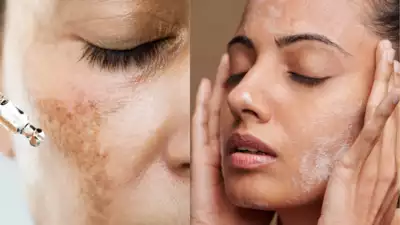Melasma, characterized by brown patches, is linked to hormonal factors, UV exposure, and genetic predisposition. Manage with sunscreen, hats, ACV toner, aloe vera, and lemon juice for noticeable results.
Health reasons that cause melasma on face
Melasma, a condition marked by brown or light brown patches on the face, neck, shoulders, and hands. While it looks like brown patches on skin that most people mistake for sunburns, there may be many underlying health reasons that might cause it. Here are some of them:
Hormonal Factors
Hormonal changes play a significant role in melasma development. This is why it’s often called the “mask of pregnancy” as it commonly affects pregnant women.
Fluctuations in hormones like estrogen and progesterone can trigger melanocytes (cells responsible for skin
pigmentation) to produce more melanin, leading to the characteristic brown patches. Hormonal medications such
as birth control pills or hormone replacement therapy can also contribute to melasma.
Sun Exposure
The sun is a major trigger for melasma. Ultraviolet (UV) rays from the sun stimulate melanocytes, causing them to produce more melanin. This is why melasma often worsens during summer or in sunny climates. It’s not just UVB rays that are problematic; UVA rays and even visible light can also contribute to melasma. This makes protection against sun exposure crucial for managing melasma.
Heat
Apart from UV radiation, heat itself can exacerbate melasma. Prolonged exposure to high temperatures, such
as during hot weather or activities that cause sweating, can worsen existing melasma or trigger its development.
Visible Light
Studies suggest that visible light, including blue light from electronic devices, can also play a role in melasma. This is
an emerging area of research, and while more studies are needed, it’s important to be aware of the potential impact
of visible light on skin pigmentation disorders like melasma.
Genetic Predisposition
There is evidence to suggest that genetics may also contribute to melasma. People with a family history of
melasma are more likely to develop the condition themselves.
Home remedies to treat melasma
Here are some home remedies that may help in managing melasma:
Lemon Juice
Lemon juice contains citric acid, which has natural bleaching properties that may help lighten dark spots.
Squeeze fresh lemon juice and apply it directly to the affected areas using a cotton ball. Leave it on for about
10-15 minutes and then rinse with lukewarm water. Repeat this process daily for several weeks to see improvement.
Aloe Vera
Aloe vera has soothing and skin-lightening properties, making it beneficial for treating melasma. Extract fresh
aloe vera gel from the leaf and apply it to the affected areas. Leave it on for 20-30 minutes before rinsing with
water. Repeat this remedy twice daily for noticeable results.
Apple Cider Vinegar Toner
Apple cider vinegar (ACV) has natural acids that can help exfoliate the skin and lighten dark spots. Dilute ACV with water in equal parts to create a toner. Apply the toner to the affected areas using a cotton pad and leave it on for a few minutes. Rinse off with water and moisturize afterward. Use this toner once daily, preferably in the evening, and follow up with sunscreen during the day.
Sun Protection
One of the most crucial aspects of managing melasma is sun protection. Always wear a broad-spectrum sunscreen with SPF 30 or higher, even on cloudy days. Reapply sunscreen every 2 hours, especially if you’re outdoors or swimming. Wear wide-brimmed hats, sunglasses, and protective clothing to shield your skin from harmful UV rays.









Leave feedback about this